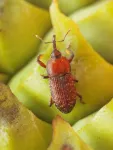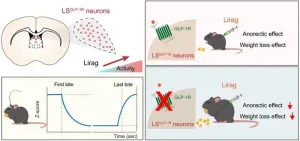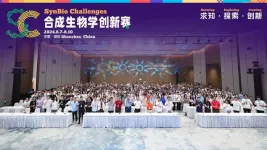The heat generated by the tissues of some plants has played a crucial role in the evolutionary history of insect pollination
A new study suggests that the ability of some plants to generate heat, known as thermogenesis, has played a key role in attracting pollinating insects for at least 200 million years
2024-09-06
(Press-News.org)
Thermogenesis is a process by which organisms generate internal heat. Although it is usually associated with animals, some plants have also developed this ability. This metabolic process allows certain parts of the plant, such as flowers and inflorescences, to raise their temperature above that of the surrounding environment. Today, these plants, which include cycads and some angiosperms (flowering plants), rely on insects for pollination. The heat they generate helps volatilize and disperse floral fragrances and other chemical compounds that attract insects such as beetles, flies, and trips to the plants. Additionally, thermogenesis stabilizes the development of reproductive organs in cold climates and facilitates the growth of pollen tubes.
Evidence in the Fossil Record
Although thermogenesis cannot be directly preserved in the fossil record, scientists can infer its presence in ancient plants by studying anatomical structures similar to those of current thermogenic plants. A new study led by the Botanical Institute of Barcelona (IBB), a joint center of the Spanish National Research Council (CSIC) and the Consorci Museu Ciències Naturals de Barcelona, in collaboration with the Complutense University of Madrid and other institutions such as the Geological and Mining Institute of Spain (IGME–CSIC), the Smithsonian Institution, the University of Barcelona, and the Royal Botanic Gardens of Sydney, has examined the characteristics of present-day thermogenic plants and compared them with fossil plant lineages.
"Our findings suggest that thermogenesis in plants is an older phenomenon than previously thought," explains David Peris, a researcher at the IBB and the lead author of the study. "200 million years ago, the diversification of flowering plants had not yet occurred. Therefore, thermogenesis could have been a crucial factor in the evolutionary success of seed plants in general, and flowering plants in particular, as well as their pollinators."
A Discovery with Evolutionary Implications
In thermogenic plants, female structures mature before male structures to avoid self-fertilization. This relates to the early divergence lines of angiosperms, which had floral chambers where the stamens and carpels closed independently. The presence of reproductive chambers in fossil plants that could have trapped pollinating insects also suggests that this feature existed in the past.
Large reproductive structures, such as perianths or cones, could also indicate thermogenesis, as they retain heat more effectively. This study has allowed scientists to identify which fossil plant lineages might have exhibited thermogenic activity, suggesting that thermogenesis has been present in seed plants for longer than previously thought.
The ability to generate heat may have given certain Mesozoic plants, more than 200 million years ago, a competitive advantage over non-thermogenic plants by attracting pollinating insects more efficiently, thus contributing to their reproductive success. This strategy for attracting pollinators could have preceded others, such as bright flower colours, and may have been influenced by past climatic changes. Moreover, thermogenesis is closely linked to the emission of fragrances, another crucial factor in attracting insects.
This study opens new lines for exploring how these interactions influenced the diversification of plants and their pollinators throughout evolutionary history. "Thermogenesis in plants is not just a botanical curiosity," notes Iván Pérez-Lorenzo, a researcher at the IBB and a participant in the study, "it is an important factor that has contributed to the success of the two most diverse groups of organisms today: insects and angiosperms, and it has key implications for understanding the evolution of pollination strategies."
END
ELSE PRESS RELEASES FROM THIS DATE:
2024-09-06
They’re tiny drug-delivery systems 1000 times smaller than a human hair, but while nanomedicines have long been hailed as the future for treating debilitating and life-threatening diseases, their journey from lab to patient has many challenges.
Now, new findings from a global team of expert scientists in academia and industry has generated world-first research quality standards that will help slash costs and reduce the time it takes to develop advanced nanomedicine treatments and make them available for patients.
Published in Nature Nanotechnology today, and led by the University of South Australia’s Dr Paul Joyce and the University ...
2024-09-06
If this galaxy is typical, then the study, published today in Nature Astronomy, indicates that our galaxy is already interacting with its closest neighbour, Andromeda.
Where does a galaxy end and deep space begin? It seems like a simple question until you look more closely at the gas that surrounds galaxies, known as the circumgalactic medium.
The halo of gas surrounding the stellar disc accounts for about 70% of the mass of the galaxy – excluding dark matter – but until now has remained something of a mystery. In the past we have only been able to observe the gas by measuring the light from a background object, ...
2024-09-06
Dark matter is the invisible force holding the universe together – or so we think. It makes up around 85% of all matter and around 27% of the universe’s contents, but since we can’t see it directly, we have to study its gravitational effects on galaxies and other cosmic structures. Despite decades of research, the true nature of dark matter remains one of science’s most elusive questions.
According to a leading theory, dark matter might be a type of particle that barely ...
2024-09-06
A widely used disinfectant worldwide, chloroxylenol, has been associated with eco-toxicological threats in water environments due to its relatively high chemical stability and massive consumption. Researchers at the School of Engineering of the Hong Kong University of Science and Technology (HKUST) have discovered a promising alternative known as 2,6-dichlorobenzoquinone (2,6-DCQ), which works more effectively in combating certain common bacteria, fungi and viruses, and can be rapidly degraded and detoxified in receiving waters.
This groundbreaking study is led by Prof. ZHANG Xiangru from HKUST's ...
2024-09-06
In some places around the globe, the lights never go off. Streetlights, roadway lighting, and illuminated signs can deter crime, make roads safer, and enhance landscaping. Undisrupted light, however, comes with ecological, behavioral, and health consequences.
In the US, some states have legislation in place to reduce light pollution; however, levels of light at night remain high in many parts of the country. Now, researchers there have investigated correlations between outside nightly light pollution and Alzheimer's disease (AD).
“We show that in the US there is a positive ...
2024-09-06
A research group led by Prof. ZHU Yingjie from the Shenzhen Institute of Advanced Technology (SIAT) of the Chinese Academy of Sciences (CAS), has revealed the essential role of lateral septum (LS) neurons in mediating anorectic and weight-lowering effects of the anti-obesity drug— liraglutide in mice.
The study was published in the Journal of Clinical Investigation on Sep. 03.
Obesity is now among the top ten chronic diseases worldwide, causing a range of health issues and increasing the medical burden. Anti-obesity medications have shown greater efficacy than lifestyle changes and diet, with lower risks and fewer side effects ...
2024-09-06
From August 7 to 10, the Third SynBio Challenges were held at the Guangming Tianan Cloud Park International Conference Center in Shenzhen, China.
The event was co-organized by Shenzhen Institute of Advanced Technology (SIAT) of the Chinese Academy of Sciences (CAS), Chinese Society of Biotechnology, Shenzhen University of Advanced Technology (SUAT), Shenzhen Institute of Synthetic Biology (iSynBio), Shenzhen Synthetic Biology Association, and the Shenzhen Industrial Innovation Center for Engineering Biology.
The SynBio Challenges aim to provide a platform for students to engage in exchange and competition within the synthetic biology ...
2024-09-06
Cruciferous vegetables, including broccoli, cabbage, kale, and cauliflower have been found to lower blood pressure, in comparison to root and squash vegetables, in middle-aged and older Australian adults with elevated blood pressure.
In a randomised, controlled, crossover trial, researchers from Edith Cowan University (ECU) found that consuming four serves a day of cruciferous vegetables resulted in a significant reduction in blood pressure, compared with four serves a day of root and squash vegetables including carrot, potato, sweet ...
2024-09-06
Dynamic service migration is a key technology in Mobile Edge Computing(MEC). In a multi-user service migration scenario, the states of all users are combined into a global state, which leads to the instability of the system and ignores the influence of multiple users. It is more and more challenging to design an effective migration strategy to balance migration costs and latency in a multi-user distributed environment.
To solve the problems, a research team led by Degan ZHANG published their new research on 15 August 2024 in Frontiers of Computer Science co-published by Higher Education Press and Springer Nature.
Considering ...
2024-09-06
Scientists at Huntsman Cancer Institute at the University of Utah (the U), the National Cancer Institute-designated cancer center for the Mountain West, have made a significant breakthrough in predicting the prognosis of triple-negative breast cancer (TNBC), a particularly aggressive disease. Their research, published in JCO Precision Oncology as part of the TOWARDS study, has led to the development of a new mechanism that accurately forecasts the aggressiveness of TNBC. This advancement could revolutionize the way doctors treat TNBC, allowing them to identify higher-risk patients and tailor precise treatments.
Currently, TNBC lacks reliable methods to predict recurrence after ...
LAST 30 PRESS RELEASES:
[Press-News.org] The heat generated by the tissues of some plants has played a crucial role in the evolutionary history of insect pollination
A new study suggests that the ability of some plants to generate heat, known as thermogenesis, has played a key role in attracting pollinating insects for at least 200 million years








